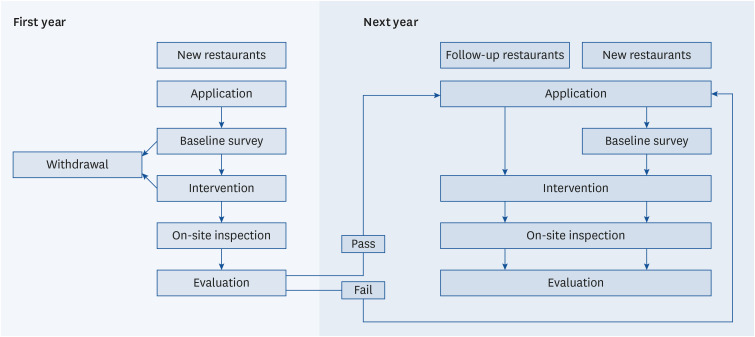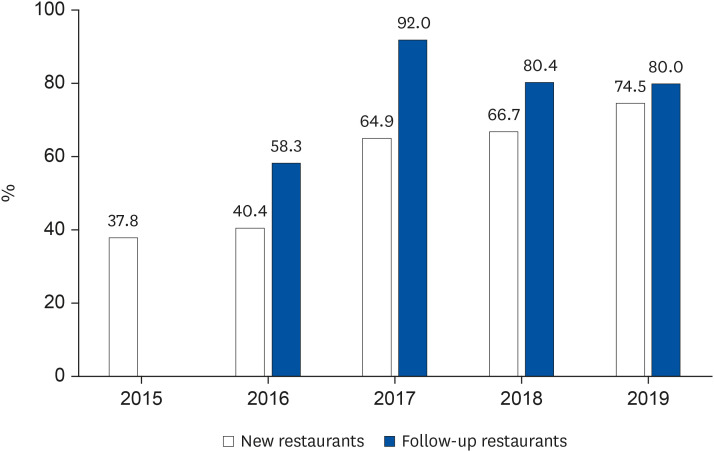Nutr Res Pract.
2022 Aug;16(4):537-548. 10.4162/nrp.2022.16.4.537.
Sodium content changes between 2015 and 2019 in restaurant menu items selected for sodium reduction in Daegu
- Affiliations
-
- 1Department of Food Science & Nutrition, Kyungpook National University, Daegu 41566, Korea
- KMID: 2532102
- DOI: http://doi.org/10.4162/nrp.2022.16.4.537
Abstract
- BACKGROUND/OBJECTIVES
South Korea has been conducting the Sodium Reduction Restaurant Project since 2015 to reduce sodium contents in restaurant menus. The purpose of this study was to analyze changes in the sodium content of menus as determined by the Daegu Sodium Reduction Restaurant Project between 2015 and 2019.
MATERIALS/METHODS
Intervention was aimed at reducing the sodium contents of over 10% of menu items in participating restaurants. On-site inspections and evaluations were conducted using a checklist, and reductions in sodium contents were determined by analyzing the salinities and sodium contents of menus after intervention.
RESULTS
Post-intervention salinities and sodium contents were significantly lower than baseline values in 2016 (P < 0.001), 2017 (P < 0.001), 2018 (P < 0.001), and 2019 (P < 0.001). However, sodium contents and salinities differences before and after intervention were not significant in 2015. Sodium contents of more than 20% of menu items offered by restaurants that participated in the Sodium Reduction Restaurant Project for 2 yrs starting in 2016 declined by 28.9%. On the other hand, the sodium reduction rate achieved by restaurants that participated for 4 yrs from 2015 reached 55.4%. The percentage of restaurants that participated in the project increased annually, though some failed to be designated as Sodium Reduction Restaurants because they did not meet sodium reduction rate requirements.
CONCLUSIONS
Positive correlations were found between duration of participation in the project and sodium reduction and designation rates. Sustainable long-term support at the national level is required to expand the project to other regions.
Keyword
Figure
Reference
-
1. GBD 2017 Diet Collaborators. Health effects of dietary risks in 195 countries, 1990–2017: a systematic analysis for the Global Burden of Disease Study 2017. Lancet. 2019; 393:1958–1972. PMID: 30954305.2. Okayama A, Okuda N, Miura K, Okamura T, Hayakawa T, Akasaka H, Ohnishi H, Saitoh S, Arai Y, Kiyohara Y, et al. Dietary sodium-to-potassium ratio as a risk factor for stroke, cardiovascular disease and all-cause mortality in Japan: the NIPPON DATA80 cohort study. BMJ Open. 2016; 6:e011632.
Article3. Mente A, O'Donnell M, Rangarajan S, McQueen M, Dagenais G, Wielgosz A, Lear S, Ah ST, Wei L, Diaz R, et al. Urinary sodium excretion, blood pressure, cardiovascular disease, and mortality: a community-level prospective epidemiological cohort study. Lancet. 2018; 392:496–506. PMID: 30129465.
Article4. Li Y, Huang Z, Jin C, Xing A, Liu Y, Huangfu C, Lichtenstein AH, Tucker KL, Wu S, Gao X. Longitudinal change of perceived salt intake and stroke risk in a Chinese population. Stroke. 2018; 49:1332–1339. PMID: 29739913.
Article5. Umesawa M, Iso H, Fujino Y, Kikuchi S, Tamakoshi A. JACC Study Group. Salty food preference and intake and risk of gastric cancer: the JACC Study. J Epidemiol. 2016; 26:92–97. PMID: 26477994.
Article6. Deckers IA, van Engeland M, van den Brandt PA, Van Neste L, Soetekouw PM, Aarts MJ, Baldewijns MM, Keszei AP, Schouten LJ. Promoter CpG island methylation in ion transport mechanisms and associated dietary intakes jointly influence the risk of clear-cell renal cell cancer. Int J Epidemiol. 2017; 46:622–631. PMID: 27789672.
Article7. Faraco G, Hochrainer K, Segarra SG, Schaeffer S, Santisteban MM, Menon A, Jiang H, Holtzman DM, Anrather J, Iadecola C. Dietary salt promotes cognitive impairment through tau phosphorylation. Nature. 2019; 574:686–690. PMID: 31645758.
Article8. Horikawa C, Yoshimura Y, Kamada C, Tanaka S, Tanaka S, Hanyu O, Araki A, Ito H, Tanaka A, Ohashi Y, et al. Dietary sodium intake and incidence of diabetes complications in Japanese patients with type 2 diabetes: analysis of the Japan Diabetes Complications Study (JDCS). J Clin Endocrinol Metab. 2014; 99:3635–3643. PMID: 25050990.
Article9. Suzuki A, Katoh H, Komura D, Kakiuchi M, Tagashira A, Yamamoto S, Tatsuno K, Ueda H, Nagae G, Fukuda S, et al. Defined lifestyle and germline factors predispose Asian populations to gastric cancer. Sci Adv. 2020; 6:eaav9778. PMID: 32426482.
Article10. Shin SJ, Lim CY, Rhee MY, Oh SW, Na SH, Park Y, Kim CI, Kim SY, Kim JW, Park HK. Characteristics of sodium sensitivity in Korean populations. J Korean Med Sci. 2011; 26:1061–1067. PMID: 21860557.
Article11. Merino J, Guasch-Ferré M, Martínez-González MA, Corella D, Estruch R, Fitó M, Ros E, Arós F, Bulló M, Gómez-Gracia E, et al. Is complying with the recommendations of sodium intake beneficial for health in individuals at high cardiovascular risk? Findings from the PREDIMED study. Am J Clin Nutr. 2015; 101:440–448. PMID: 25733627.
Article12. World Health Organization. Guideline: sodium intake for adults and children [Internet]. Geneva: World Health Organization;2012. cited 2020 November 23. Available from: https://www.who.int/elena/titles/guidance_summaries/sodium_intake/en/.13. World Health Organization. Global action plan for the prevention and control of noncommunicable diseases 2013–2020 [Internet]. Geneva: World Health Organization;2013. cited 2019 April 25. Available from: https://apps.who.int/iris/bitstream/handle/10665/94384/9789241506236_eng.pdf?sequence=1&isAllowed=y.14. Breslin PA. An evolutionary perspective on food and human taste. Curr Biol. 2013; 23:R409–R418. PMID: 23660364.
Article15. Puska P, Vartiainen E, Tuomilehto J, Salomaa V, Nissinen A. Changes in premature deaths in Finland: successful long-term prevention of cardiovascular diseases. Bull World Health Organ. 1998; 76:419–425. PMID: 9803593.16. Holdsworth M, Haslam C, Raymond NT. Does the heartbeat award scheme change employees' dietary attitudes and knowledge? Appetite. 2000; 35:179–188. PMID: 10986111.
Article17. He FJ, Brinsden HC, MacGregor GA. Salt reduction in the United Kingdom: a successful experiment in public health. J Hum Hypertens. 2014; 28:345–352. PMID: 24172290.
Article18. World Action on Salt & Health. World Action on Salt & Health in USA [Internet]. London: Wolfson Institute of Preventive Medicine, Queen Mary University of London;2020. cited 2020 November 23. Available from: http://www.worldactiononsalt.com/worldaction/north-america/usa/.19. World Action on Salt & Health. World Action on Salt & Health in Korea [Internet]. London: Wolfson Institute of Preventive Medicine, Queen Mary University of London;2020. cited 2020 November 23. Available from: http://www.worldactiononsalt.com/worldaction/asia/korea/.20. Korea Health Industry Development Institute. National Food & Nutrition Statistics 2019: based on 2019 Korea National Health and Nutrition Examination Survey [Internet]. Cheongju: Korea Health Industry Development Institute;2019. cited 2022 February 17. Available from: https://www.khidi.or.kr/kps/dhraStat/result16?menuId=MENU01670&gubun=&year=2019&category=sodium.21. Ministry of Health and Welfare. 1st National nutrition management basic plan 2012–2016 [Internet]. Sejong: Ministry of Health & Welfare;2012. cited 2019 November 21. Available from: http://www.korea.kr/common/download.do?tblKey=EDN&fileId=205580.22. Ministry of Food and Drug Safety. Guidelines for operating and managing sodium reduction restaurants 2018 [Internet]. Cheongju: Ministry of Food and Drug Safety;2017. cited 2019 September 27. Available from: https://www.foodsafetykorea.go.kr/portal/board/boardDetail.do?menu_no=2880&bbs_no=bbs110&ntctxt_no=1065772&menu_grp=MENU_NEW05.23. Ministry of Health and Welfare, Korea Disease Control and Prevention Agency. Korea Health Statistics 2020: Korea National Health and Nutrition Examination Survey (KNHANES VIII-2) [Internet]. Cheongjusi: Ministry of Health and Welfare.24. Ma J, Lee S, Kim K, Lee YK. Sodium reduction in South Korean restaurants: a Daegu-based intervention project. Asia Pac J Clin Nutr. 2020; 29:404–413. PMID: 32674248.25. Ministry of Food and Drug Safety. Restaurant menu nutrient book 2012–2017. Cheongju: Ministry of Food and Drug Safety;2019. cited 2019 October 21. Available from: https://www.foodsafetykorea.go.kr/portal/board/board.do?menu_grp=MENU_NEW05&menu_no=3601&id%20x_1=8.26. Moran AJ, Ramirez M, Block JP. Consumer underestimation of sodium in fast food restaurant meals: results from a cross-sectional observational study. Appetite. 2017; 113:155–161. PMID: 28235618.
Article27. Nakadate M, Ishihara J, Iwasaki M, Kitamura K, Kato E, Tanaka J, Nakamura K, Ishihara T, Shintani A, Takachi R. Effect of monitoring salt concentration of home-prepared dishes and using low-sodium seasonings on sodium intake reduction. Eur J Clin Nutr. 2018; 72:1413–1420. PMID: 29321686.
Article28. Kim SH, Kim MS, Lee MS, Park YS, Lee HJ, Kang S, Lee HS, Lee KE, Yang HJ, Kim MJ, et al. Korean diet: characteristics and historical background. J Ethn Food. 2016; 3:26–31.
Article29. Shim E, Ryu HJ, Hwang J, Kim SY, Chung EJ. Dietary sodium intake in young Korean adults and its relationship with eating frequency and taste preference. Nutr Res Pract. 2013; 7:192–198. PMID: 23766880.
Article30. Bobowski N. Shifting human salty taste preference: potential opportunities and challenges in reducing dietary salt intake of Americans. Chemosens Percept. 2015; 8:112–116. PMID: 26451233.
Article31. Lee J, Park S. Management of sodium-reduced meals at worksite cafeterias: perceptions, practices, barriers, and needs among food service personnel. Osong Public Health Res Perspect. 2016; 7:119–126. PMID: 27169011.
Article32. Musicus AA, Moran AJ, Lawman HG, Roberto CA. Online randomized controlled trials of restaurant sodium warning labels. Am J Prev Med. 2019; 57:e181–e193. PMID: 31753271.
Article
- Full Text Links
- Actions
-
Cited
- CITED
-
- Close
- Share
- Similar articles
-
- Study on Sodium Reduction: 'Healthy Restaurant for Sodium Reduction'
- Measurements of Salinity and Salt Content by Menu Types Served at Industry Foodservice Operations in Daegu
- Comparison of Sodium Reduction Practice and Estimated Sodium Intake by Salty Food Preference on Employees and Customers of Sodium Reduction Restaurant in Daegu, Korea
- Comparison of the sodium content of Korean soup-based dishes prepared at home, restaurants, and schools in Seoul
- Current status, perception and practicability of restaurant staffs related to reducing sodium use in Seongnam, Korea



